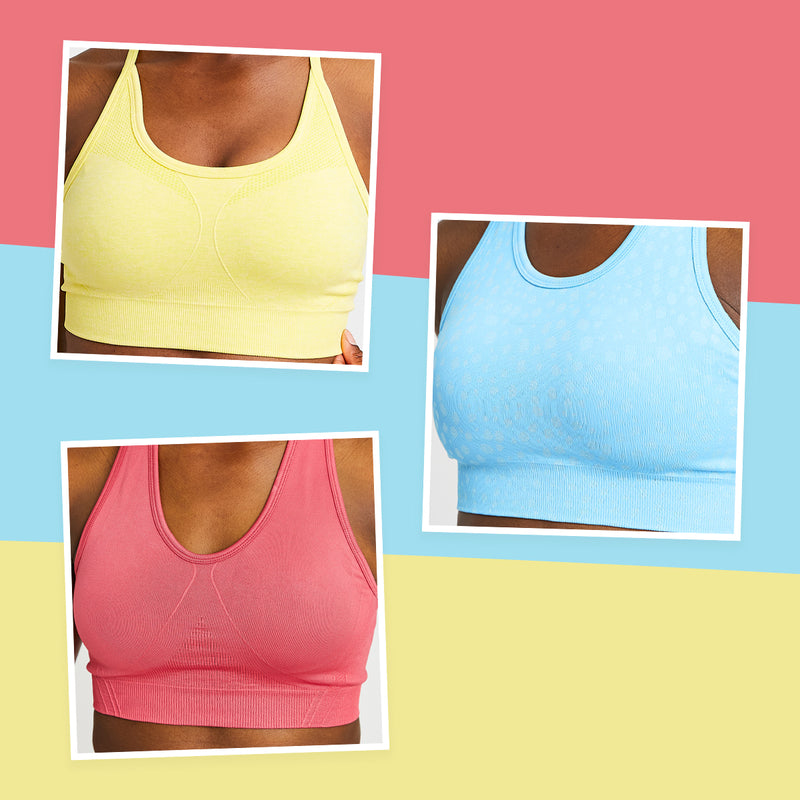
How To Pick The Perfect Sports Bra For Your Workout
As uplifting as your morning cup of coffee and as supportive as your bestie, a sports bra is a serious game-changer when it comes to working out.
But did you know as many as 80% of women in the UK are wearing the wrong bra size? Well, ladies, we’re here to put that right because there really is nothing worse than suffering through a workout in the wrong sports bra. Trust us!
From finding the right level of support to understanding how a sports bra should fit, here’s everything you need to know.
WHY DO I NEED TO WEAR A SPORTS BRA?
To put it simply, when you move, whether you’re running, training in the gym or doing a set of mobility exercises, your boobs move too. Without the right support, this can cause some serious discomfort, including soreness and over-stretching of your ligaments.
A sports bra is designed to reduce this movement without restricting your workouts, so you can work towards hitting your next PB without any distractions.
As with all of our designs, our Sports Bras are created with your comfort in mind, so you can unlock your full potential and move with confidence.
HOW TO FIND THE RIGHT SPORTS BRA
First things first, you need to consider the level of support required. This will depend on the intensity of your workout. The higher the intensity, the more power there is behind your movement, causing your boobs to, well, bounce around more.
When to wear a light support sports bra:
Low support bras are perfect for LISS, such as yoga, walking and pilates, as they provide the perfect balance of support and ease of movement.
Opt for a style with endless flexibility, such as our Motion Seamless Sports Bra. Designed with an ultra soft and stretchy material and adjustable cross back straps for added support, our best-selling sports bra is the picture of comfort.
When to wear a medium support sports bra:
Prepping for a spin session or a dance class? For harder-hitting workouts, you need a sports bra with more support, like our Evolve Speckle Seamless Sports Bra. Complete with thick supportive straps and a flattering racer back design, this sports bra is designed to stay put even when the pace picks up.
If you prefer something a bit more classic, our Training Bra is a workout staple. Featuring an open back detail and mesh panelling to keep you comfortably cool, this is made for those who make a pledge to progress.
When to wear a high support sports bra:
High intensity workouts require high-performance, reliable activewear, which is exactly what our Balance V2 Seamless Bra provides. Combining unbeatable support with a premium compressive fit, this most-loved style is designed to give you the confidence to achieve it all.
Just like our Sportive Zip Up Sports Bra. Made from a flexible fabric that will allow you to take your performance to new heights, this sleek style provides support like no other even during the most intensive workouts. Complete with adjustable cross back straps, you can adjust the fit as you please.
If you’re blessed with bigger breasts (D cup or above), we recommend wearing a high support sports bra for every kind of workout.
HOW SHOULD A SPORTS BRA FIT?
Support comes from three aspects of a sports bra: the straps, the cups and the band, so it’s important to pay close attention to these details when trying on your new ‘fit. Here’s some top tips to help you find the right sports bra for you.
HOW TO MEASURE FOR A SPORTS BRA
Step 1: Measure around your rib cage, just below your breasts. The tape measure should be snug, but loose enough that you can fit two fingers underneath. Round down to the nearest whole inch.
Step 2: Use the table below to find your corresponding band size.

Step 3: Measure around the fullest part of your breast. As before, the tape measure should fit snug, but not too tight that it restricts breathing.
Step 4: Subtract your rib cage measurement from your bust measure. The difference is your cup size. See below.

Step 5: Use our size chart to find your sports bra size.
As you can see, girls, there’s a lot more to finding the right sports bra than ‘liking the way it looks’. It may be that you need to try a number of styles and/or sizes before you find your perfect fit. Luckily for you, we’ve got plenty of comfort-first and performance-focused pieces to suit every shape, every style and every workout. Because finding the right fit is just as important to us as it is to you.



